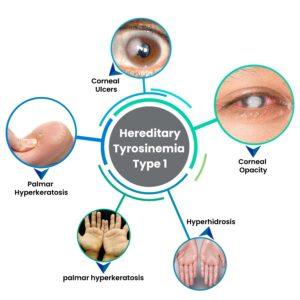
Hereditary Tyrosinemia Type 1
Hereditary Tyrosinemia Type 1, often referred to as HT-1, is an ultra-rare but serious disorder that leaves individuals unable to break down the amino acid tyrosine completely. This causes a life-threatening and serious accumulation of toxic metabolites in the patient’s body, which can lead to severe liver and kidney problems; those affected typically need a specific diet and medicine (Nitisinone, sometimes called NTBC) for the management of the genetic disorder. Understanding its nomenclature, affected demographics, and global prevalence trends is important for both medical specialists and the general population.
Nomenclature:
The term ” tyrosinosis” was earlier considered to refer to tyrosinemia type-1, including tyrosinosis. HT1, also addressed as Tyrosinemia Type 1 or Fumarylacetoacetase Deficiency occurs due to mutations in the FAH gene. This gene specifically encodes an enzyme necessary for the breakdown of tyrosine. When this enzyme is deficient, toxic byproducts accumulate, leading to critical health issues.
Affected Demographics:
Hereditary Tyrosinemia Type-1 affects people of all ethnicities, but its incidence typically varies among populations. The disorder is more prevalent in some ethnic groups, like the Quebecois groups in Canada, where a founder effect has caused a greater prevalence. It is an autosomal recessive disorder, meaning both parents must carry the gene (mutated) for their child to inherit the disease. It mainly affects infants and young children, with signs and symptoms often occurring within the initial few months of life. Some common signs include kidney problems, failure to thrive, and liver enlargement.
Global Prevalence Trends:
In geographic places without newborn screening, HT-1 affects around one in 100,000 to 120,000 births. Due to the inconsistent and confusing nature of its clinical presentation, it is supposed that fewer than 50 % of affected people are diagnosed while alive. The carrier frequency of the general US population is around 1:150 to 1:100.
Two territories of the planet have a greater-than-expected frequency of HT-1 because of the enhanced frequency of some pathogenic variants resulting from a founder effect:
- In the Scandinavian nations and Finland, the birth prevalence is roughly calculated at 1:74,000 and 1:60,000 live births, respectively.
- A founder effect from colonization by French settlers exists in the areas of Quebec, Canada. The pathogenic variant typically accounts for 87 percent of allelic variants in this group. The birth prevalence in the areas of Quebec is 1:16,000. In the Saguenay-Lac Saint-Jean area of Quebec, there are 1:1,846 live births. Quebec`s overall carrier frequency is 1:66 on behalf of newborn screening findings. The Saguenay-Lac St-Jean region’s carrier frequency is 1:16-1:20.
Conclusion:
HT-1 presents a complex challenge in the realm of rare genetic diseases or disorders. Understanding its nomenclature, affected demographics, and global prevalence trends is necessary for early detection and intervention. With advances in medical science, the prognosis for people with HT1 continues to enhance, offering hope for patients affected by this disease and their families. Management generally involves a low-tyrosine diet, medicine (like Nitisinone generic), and, in specific cases, liver transplantation.
Reference:

